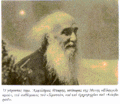Difference between revisions of "Patriarchal Exarchate of Patmos"
m |
m (→Saints and Monastics) |
||
| Line 31: | Line 31: | ||
== Saints and Monastics == | == Saints and Monastics == | ||
*St. [[John the Theologian]] ([[September 26]] and [[May 8]]) | *St. [[John the Theologian]] ([[September 26]] and [[May 8]]) | ||
| − | *St. [[Christodoulos the Latrinos]] ([[March 16]] and [[October 21]]) | + | *St. [[Christodoulos the Latrinos]], monk and wonder-worker of Patmos ([[March 16]] and [[October 21]]) |
*[[Apostle Thomas]] (First Sunday of Pentecost and [[October 6]]) | *[[Apostle Thomas]] (First Sunday of Pentecost and [[October 6]]) | ||
*St. Gerasimos of the Byzantium ([[April 7]]) | *St. Gerasimos of the Byzantium ([[April 7]]) | ||
Revision as of 00:38, May 5, 2008
The Patriarchal Exarchate of Patmos (Greek Πάτμος) is the small Greek island pf Patmos, also referred to as the Jerusalem of the Aegean Sea, since it is the island of ascetic austerity. This exarchate belongs to the Patriarchate of Constantinople.
Contents
History
Patmos is the northernmost island of the Dodecanese and is populated with churches and communities of Orthodox Christians. From the very earliest times, Orthodox tradition has associated Patmos with St. John the Theologian; on this island is the cave of his exile and from where he wrote the Book of Revelation. More specifically, it is remembered as the place where he recorded his vision from Jesus that came to us as the Book of Revelation. Revelation was written as an exhortation to the Christian believers to stay true to their faith during the persecutions near the end of the first century.[1]
The whole island is dominated by the two monasteries, built in his honour and memory, and Chora, the island’s historic center, are all declared World Heritage sites by UNESCO in 2006.
Monastery of St. John the Theologian
The Monastery of Saint John the Theologian was founded by St. Christodoulos the Latrinos 1088 ad, who had been granted the whole island of Patmos with a golden bull by the Emperor of Byzantium Alexis I Komninos. The monastery belongs to the Ecumenical Patriarchate; and is therefore a Patriarchal exarchate with a Patriarchal exarch, its abbot had special benefits.
The Monastery has ten chapels, four of which are located in its yard. In the Catholic of the monastery, there is a temple of unique art, created in 1829, by 12 sculptors.
Cave of the Apocalypse
The Cave of the Apocalypse is situated between Skala and Chora. The view from the cave and the mysticism of the atmosphere are incredible. When he first arrived in Patmos, Christodoulos the Latrinos refurbished the cave. Today, a pilgrim can see the place at which the Apocalypse was written, the place where St. John stayed, the massive rock that opened up in there and through which God dictated the Apocalypse to St. John, the point were the Evangelist lay his head to rest and a curve on the rock, which he would hold onto, in order to rise - the southern part of the cave has been turned into a church.
List of Churches and Monasteries
Saints and Monastics
- St. John the Theologian (September 26 and May 8)
- St. Christodoulos the Latrinos, monk and wonder-worker of Patmos (March 16 and October 21)
- Apostle Thomas (First Sunday of Pentecost and October 6)
- St. Gerasimos of the Byzantium (April 7)
- St. Antipas Bishop of Pergamon (April 11)
- Virgin-martyr St. Pachomius of Russia (May 7)
- St. Leontas Archbishop of jerusalem (May 14)
- St. Phillip the Deacon (October 11)
- St. Macarius of Kalogera (January 19)
- Hieromartyr Platonos of Aivazidos (September 21)
Ancient Icon of St. John the Theologian
Notes
- ↑ P. N. Tarazi, The New Testament - Introduction, Vol. 3 - Johannine Writings, St. Vladimir's Seminary Press, Crestwood, New York, 2004 ISBN 0-88141-264-3








